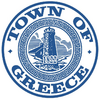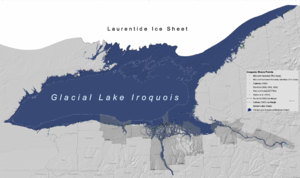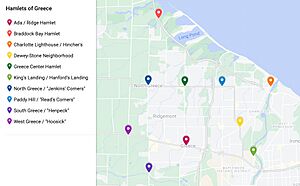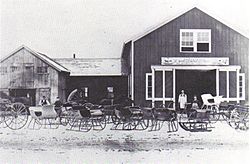Greece, New York facts for kids
Quick facts for kids
Town of Greece
|
||
|---|---|---|
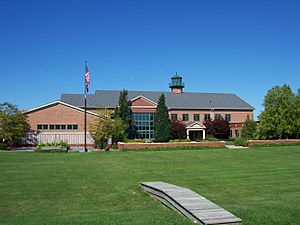
Greece Town Hall
|
||
|
||
| Nickname(s):
Town of Good People
|
||
| Motto(s):
Discover the Promise
|
||
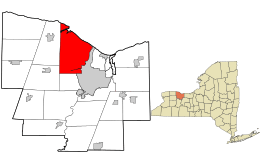
Location in Monroe County and the state of New York.
|
||
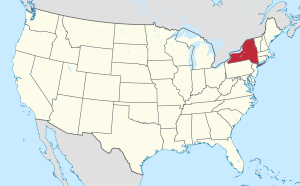
Location of New York in the United States
|
||
| Country | United States | |
| State | New York | |
| County | Monroe | |
| Established | March 22, 1822 | |
| Named for | Greece | |
| Government | ||
| • Type | Town council | |
| Area | ||
| • Total | 51.39 sq mi (133.11 km2) | |
| • Land | 47.52 sq mi (123.08 km2) | |
| • Water | 3.87 sq mi (10.03 km2) | |
| Elevation | 424 ft (129 m) | |
| Population
(2010)
|
||
| • Total | 96,095 | |
| • Estimate
(2019)
|
95,499 |
|
| • Density | 2,023.80/sq mi (781.39/km2) | |
| Time zone | UTC-5 (EST) | |
| • Summer (DST) | UTC-4 (EDT) | |
| ZIP code |
14612, 14615, 14616, 14626
|
|
| Area code(s) | 585 | |
| FIPS code | 36-055-30290 | |
| Website | http://www.greeceny.gov/ | |
Greece is a large town in Monroe County, New York, United States. It's a suburb of Rochester, New York. Greece is the biggest town in Monroe County by population. It is also the second-largest city or town in the county, right after Rochester itself.
The town is located west of the Genesee River in northern Monroe County. It shares borders with Rochester to the east and Lake Ontario to the north. To the south is the town of Gates, and to the west are Parma and Ogden. Greece is a continuous suburb of Rochester. As of 2024, about 93,928 people live in the Town of Greece.
Contents
History of Greece
Early People and Explorers
Long ago, around 1300 AD, Native American tribes lived near the Finger Lakes. They moved north towards Lake Ontario and the Genesee River. These tribes were Iroquoian, related to the Seneca. They traded with the Algonquin and Huron tribes.
By 1550 AD, the Seneca, Mohawk, Oneida, Cayuga, and Onondaga tribes formed the Iroquois Confederacy. The Tuscarora later joined them. This powerful group controlled the region for 200 years.
The first European to visit was French explorer Rene-Robert Cavelier in 1669. French and British soldiers often passed through as their countries fought for control. European settlers began arriving in the late 1790s. This was after the land was officially bought from the Seneca people.
First Settlers
After the American Revolutionary War ended in 1783, the new government wanted people to settle western lands. In 1792, the first settlers arrived in what would become Greece. William Hincher, a veteran of the Revolutionary War, and his family built a cabin in 1794. They bought 627 acres of land in what is now Charlotte.
After William died in 1817, his wife Mehitable helped create a deed. This deed allowed the U.S. government to build the Charlotte–Genesee Lighthouse on their land. The lighthouse was built in 1822.
In 1797, Kings Landing was founded by the King and Granger families. It was the first European settlement and port west of the Genesee River. The settlement was hit by malaria and almost disappeared. In 1807, seven Hanford brothers revived it, renaming it "Hanford's Landing." They built a mill, a hotel, and a shipping center.
In 1805, James and Sarah Latta bought large plots of land in Charlotte. Their son Samuel built a home and warehouse there in 1806. He became the Customs Agent for the Port of Charlotte. Samuel Latta's home still stands today.
Greece During the War of 1812
On October 1, 1812, a British warship, H.M.S. Royal George, arrived at the Genesee River. British marines took a U.S. ship and a private schooner. The next day, they returned for more supplies, including whiskey.
On June 15, 1813, British ships led by Commodore James Yeo entered the Genesee River. They heard that American troops had supplies in Charlotte. 150 British sailors came ashore and took the supplies. They also seized a ship belonging to Erastus Spaulding.
To stop the people of Charlotte from warning the militia, the British locked them up. A few men escaped and alerted the militia, who were about 7 miles away. Colonel Caleb Hopkins led the militia to Charlotte. They arrived just as the British ships were sailing away.
On September 11, 1813, the American fleet, led by Commodore Isaac Chauncey, found the British fleet near Braddock Bay. The American ships, including the USS Pike, fired cannons at the British for 90 minutes. However, the American ships were hard to steer, and the British escaped.
On May 15, 1814, British ships were seen off Charlotte. Colonel Isaac Stone and 33 men from Greece and nearby towns gathered. They marched all night and reached the Genesee River at dawn. Heavy fog made the British think a larger force was waiting.
Stone refused to surrender the supplies in Charlotte. The British sent a gunboat. Stone's militia fired their cannon too early. The British fired back, hitting a warehouse. Later that day, General Peter Porter arrived with 600-800 militia members. The British again demanded surrender and threatened to land an army. General Porter refused. Not knowing how many men were defending Charlotte, the British ships sailed away on May 16, 1814.
How Greece Became a Town
In the late 1700s, new counties were formed in New York State. By 1789, Ontario and Genesee counties existed. In 1797, a region called Northampton was created. This area included what is now Parma, Riga, Gates, Ogden, Chili, and Greece.
In 1808, Northampton was divided into four towns. The area of present-day Gates and Greece remained Northampton until Gates was officially formed in 1813. In 1821, Monroe County was created from parts of Ontario and Genesee counties.
On March 22, 1822, the state government divided Gates into the towns of Gates and Greece. This change took effect on April 1, 1822. Greece received more land because people thought much of its northern part was unusable swamp. The name Greece was chosen to support the Greek War of Independence against the Ottoman Empire.
Growth and Changes Over Time
The Erie Canal section through Greece was finished by 1822. The small village of "South Greece" (now Henpeck Park) grew to serve canal travelers and workers. Some stone masons from Europe who built the canal stayed. They are believed to have built the unique cobblestone homes found in this region. Three such homes still stand in Greece today.
Throughout the 1800s, Greece was mostly a farming community. Its population stayed around 5,000 people. More small villages like North Greece and West Greece were formed. Much of the town's business centered on the port of Charlotte. Charlotte became a village in 1869. It could handle up to 100 ships a day.
Greece's location near Lake Ontario made it a popular vacation spot in the late 1800s. The Ontario Beach Amusement Park (1884-1919) was called the "Coney Island of the West." Another park at Manitou Beach (1890s-1920s) was connected to Charlotte by a railway. Grand hotels like the Manitou Hotel were built for visitors. The Dentzel Menagerie Carousel at Ontario Beach Park is a reminder of those fun times.
Around this time, Greece's economy began to change from farming to industry. In 1891, George Eastman opened the first Kodak plant in the town. This plant became known as Kodak Park. Kodak grew to be the largest employer in the Rochester area. Its success directly led to Greece's growth. As Rochester expanded, it took over large parts of Greece. Charlotte was annexed in 1916, and Kodak Park in 1918.
This economic shift continued between the World Wars. Bad weather, like a severe freeze in 1934, destroyed many orchards. Many farmers couldn't recover and sold their land for new homes. Because it was close to Kodak Park, Greece changed a lot. New houses were built for soldiers returning from World War II. Many factory workers and their families moved to Greece. The population grew quickly from about 15,000 in 1940 to almost 50,000 by 1960. By 1967, it was nearly 75,000.
Geography of Greece
At the end of the last ice age, around 11,000 BCE, a huge prehistoric lake covered much of Greece. This lake, called Lake Iroquois, was much larger than today's Lake Ontario. Glacial ice blocked its drainage to the St. Lawrence River.
As the glaciers melted, Lake Iroquois's waters dropped. This left behind a ridge of land about 7 to 7.5 miles from the current shoreline. This ridge rises about 160 feet above Lake Ontario. The soil left behind was rich and good for farming. Native Americans used this ridge as a path. Today, it's the town's main road, known as "the Ridge."
Between 1801 and 1804, Abel Rowe opened a tavern on Ridge Road. He expected it to become a major route. For a while, it was one of only two buildings on the Ridge between the Genesee River and Lewiston. During the War of 1812, the Ridge was important for moving troops and supplies. In 1813, New York State spent $5,000 to improve the road. In 1816, stagecoaches began using Ridge Road.
By the mid-1800s, Ridge Road had many farms and mansions. A part of Ridge Road was covered with planks in the 1860s, like a boardwalk. But most of it remained a dirt road until the early 1900s.
In 1900, Ridge Road became New York State Route 104. Money was given to improve it. As cars became popular, fewer taverns and hotels were needed. Blacksmiths and carriage makers were replaced by gas stations and repair shops. Route 104 was rebuilt in 1926 for cars. By the 1940s, thousands of Greece residents used the Ridge daily to work at Kodak. This often caused traffic jams. The Ridge was widened in 1956, 1978, and again in 2008. The last of the old taverns, Streb’s Steak House, was torn down in 2013. Today, shopping centers, restaurants, and car dealerships line Ridge Road.
Besides the Ridge, the northern part of Greece has wetlands and many ponds. These include Cranberry Pond, Long Pond, and Braddock Bay. They are along the shoreline of Lake Ontario. This area has the lowest elevation in Greece, at 243 feet above sea level.
The highest point in Greece is south of Ridgeway Avenue, near Interstate 390. It is 558 feet above sea level.
Demographics of Greece
| Historical population | |||
|---|---|---|---|
| Census | Pop. | %± | |
| 1830 | 2,574 | — | |
| 1840 | 3,669 | 42.5% | |
| 1850 | 4,219 | 15.0% | |
| 1860 | 4,147 | −1.7% | |
| 1870 | 4,314 | 4.0% | |
| 1880 | 4,848 | 12.4% | |
| 1890 | 5,145 | 6.1% | |
| 1900 | 5,579 | 8.4% | |
| 1910 | 7,777 | 39.4% | |
| 1920 | 3,350 | −56.9% | |
| 1930 | 12,113 | 261.6% | |
| 1940 | 14,925 | 23.2% | |
| 1950 | 25,508 | 70.9% | |
| 1960 | 48,670 | 90.8% | |
| 1970 | 75,136 | 54.4% | |
| 1980 | 81,367 | 8.3% | |
| 1990 | 90,106 | 10.7% | |
| 2000 | 94,141 | 4.5% | |
| 2010 | 96,095 | 2.1% | |
| 2023 (est.) | 94,591 | −1.6% | |
| U.S. Decennial Census | |||
According to the census of 2020, Greece had 96,926 people. There were 43,885 households and 25,748 families living in the town. The population density was about 2,040 people per square mile.
About 54.9% of households were married couples living together. About 13.9% had a female head of household with no husband. The average household size was 2.2 people. The typical value of a home owned by its residents was $185,100.
The population was spread out by age. About 17.1% were under 18 years old. About 23.8% were 65 years or older. The average age in Greece was 46.2 years. Males made up 48.9% of the population, and females made up 51.1%.
The average income for a household in Greece was $64,867. For families, the average income was $90,950. The average income for married families was $101,340. The average income per person in the town was $39,510. About 10.39% of the population lived below the poverty line. This included 9.1% of those under 18 and 8.1% of those 65 or older.
Education in Greece
Education in Greece started early, with the first school commissioner elected in 1798. In 1823, the town was divided into Common School Districts. By the late 1800s, Greece had seventeen Common School Districts. Only Common School District #15 - Barnard School still operates as a school today. It is now Derech HaTorah, a private Jewish school.
School districts began to combine in 1928. Districts 3, 11, and 16 formed Greece Central School District #1 - Hoover Drive. Greece was the first centralized school district in Monroe County. It was the thirteenth in New York State.
After World War II, Greece's population grew quickly. The Greece Central School District expanded to serve more students. Olympia High School opened in 1959. Before this, students went to Charlotte High School or John Marshall High School in Rochester. Two more high schools followed: Arcadia High School (1963) and Athena High School (1969). The Hoover Drive School became Odyssey Academy. It moved to the former Cardinal Mooney High School building in 2012.
Today, three school districts serve Greece: the Greece Central School District, the Hilton Central School District, and the Spencerport Central School District. The Greece Central School District educates about 11,000 students. It is the seventh largest school district in New York State, not counting New York City. Its post-elementary schools have names and mascots from Classical Greek. Private schools in Greece include the Greece Montessori School, Rochester Academy Charter High School, Dorech HaTorah Jewish School, and St. Lawrence Catholic School.
| Motto: "One Vision, One Team, One Greece" | ||||
|---|---|---|---|---|
| Elementary Schools | Grades | Middle & High Schools | Grades | |
| Autumn Lane | PreK-2 | Arcadia Middle School | 6-8 | |
| Brookside | K-5 | Arcadia High School | 9-12 | |
| Buckman Heights | 3-5 | Athena Middle School | 6-8 | |
| Craig Hill | 3-5 | Athena High School | 9-12 | |
| English Village | K-2 | Odyssey | 6-12 | |
| Greece Community Early Learning Center | PreK-2 | Olympia | 6-12 | |
| Holmes Road | PreK-2 | Phoenix Academy | 7-12 | |
| Lakeshore | 3-5 | |||
| Long Ridge | K-5 | |||
| Paddy Hill | K-5 | |||
| Pine Brook | K-5 | |||
Notable Landmarks
Notable People
- Frank Beaty, Professional Basketball Player
- Jessie Bonstelle, Actress and Theatre Producer
- Michele Brekke, First Female NASA Flight Director
- Ryan Callahan, Professional Hockey Player
- Jennifer Cody, Actress
- Fred Eckert, Politician and Diplomat
- Jason McElwain, Amateur Athlete and Public Speaker
- Andrew McKay, Professional Soccer Player
- Enoch Pardee, Doctor and Politician
- Joe Robach, Politician
- Fred Slater, Lawyer and Politician
- Blanche Stuart Scott, Aviation Pioneer (born near the Greece / Gates border)
See also
 In Spanish: Greece (Nueva York) para niños
In Spanish: Greece (Nueva York) para niños


